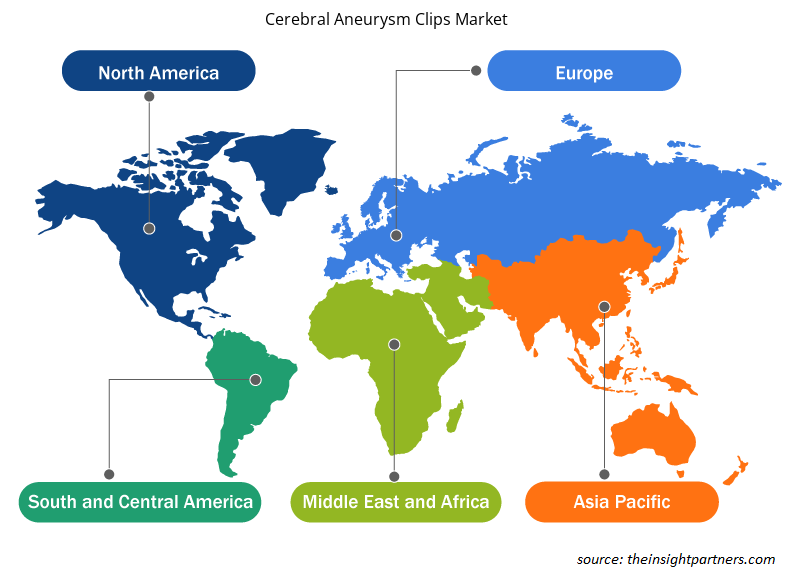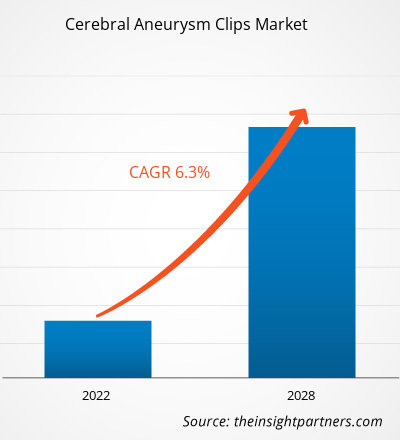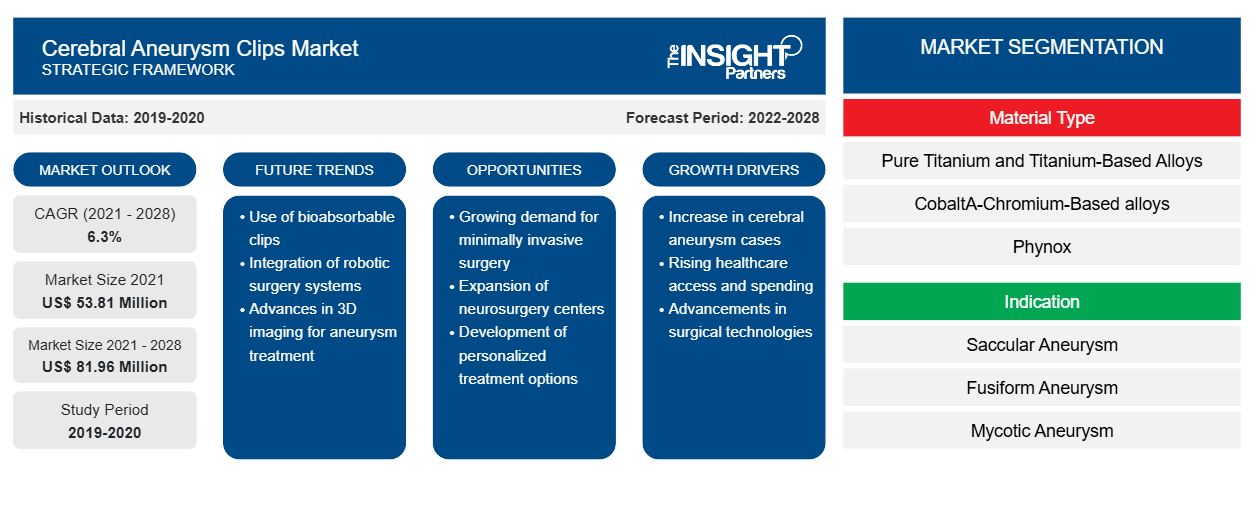Si prevede che il mercato delle clip per aneurisma cerebrale crescerà da 53.810,74 mila dollari USA nel 2021 a 81.960,74 mila dollari USA entro il 2028. Si stima che crescerà a un CAGR del 6,3% dal 2022 al 2028.CAGR of 6.3% from 2022 to 2028.
Un aneurisma cerebrale è lo sviluppo di un rigonfiamento nei vasi sanguigni del cervello. Il rigonfiamento esercita pressione sui nervi o sui tessuti cerebrali e la rottura o lo scoppio possono causare emorragia cerebrale, che può essere fatale per un paziente. Fattori come condizioni genetiche, malformazioni artero-venose, ipertensione non trattata e fumo causano aneurismi cerebrali. Il clipping microchirurgico è il metodo più consolidato per trattare gli aneurismi. Il primo aneurisma mai trattato con clipping chirurgico è stato eseguito al Johns Hopkins Hospital il 23 marzo 1937. Durante il clipping microchirurgico, viene utilizzata una piccola clip metallica per interrompere il flusso di sangue nell'aneurisma. Viene eseguita una craniotomia per creare un'apertura nel cranio per raggiungere l'aneurisma. La clip viene posizionata sul collo (apertura) dell'aneurisma per ostruire il flusso di sangue e viene lasciata all'interno del cervello dopo le procedure.arteriovenous malformations, untreated high blood pressure, and smoking cause brain aneurysms. Microsurgical clipping is the more established method of treating aneurysms. The first aneurysm ever treated by surgical clipping was performed at Johns Hopkins Hospital on March 23, 1937. During microsurgical clipping, a small metal clip is used to stop blood flow into the aneurysm. A craniotomy is performed to create an opening in the skull to reach the aneurysm. The clip is placed on the neck (opening) of the aneurysm to obstruct the flow of blood and it is left inside the brain after the procedures.
Il rapporto offre approfondimenti e analisi approfondite del mercato globale delle clip per aneurisma cerebrale , sottolineando vari parametri tra cui tendenze di mercato, progressi tecnologici, dinamiche di mercato e analisi del panorama competitivo dei principali attori del mercato globale. Include anche l'impatto della pandemia di COVID-19 sul mercato in tutte le principali regioni. Il mercato delle clip per aneurisma cerebrale ha sperimentato l'impatto misto complessivo della pandemia di COVID-19 e, quindi, il mercato sta ancora guadagnando terreno e si prevede che crescerà nei prossimi anni. Durante questa emergenza sanitaria, fornire assistenza medica a tutti i pazienti è diventato difficile per i sistemi sanitari, che sono stati sovraccaricati a causa della necessità di curare il vasto numero di pazienti COVID. Anche le aziende di dispositivi medici hanno dovuto affrontare problemi nella gestione delle loro operazioni nel 2020. Tuttavia, con il graduale allentamento delle restrizioni sociali e la ripresa delle procedure elettive da parte degli ospedali, la domanda di procedure chirurgiche e relativi accessori è tornata a livelli normali.
Mercato delle clip per aneurisma cerebrale -
Personalizza questo report in base alle tue esigenze
Riceverai la personalizzazione gratuita di qualsiasi report, comprese parti di questo report, o analisi a livello nazionale, pacchetto dati Excel, oltre a usufruire di grandi offerte e sconti per start-up e università
-
Scopri le principali tendenze di mercato in questo rapporto.Questo campione GRATUITO includerà analisi di dati che spaziano dalle tendenze di mercato alle stime e alle previsioni.
Approfondimenti basati sulla geografia
In base alla geografia, il mercato delle clip per aneurisma cerebrale è segmentato in Nord America (Stati Uniti, Canada e Messico), Europa (Francia, Germania, Regno Unito, Spagna, Russia, Italia e resto d'Europa), Asia Pacifico (Cina, India, Giappone, Australia, Corea del Sud, Kazakistan e resto dell'Asia Pacifico), Medio Oriente e Africa (Arabia Saudita, Emirati Arabi Uniti, Sudafrica e resto del Medio Oriente e dell'Africa) e Sud e Centro America (Brasile, Argentina e resto del Sud e Centro America).UAE, South Africa, and Rest of Middle East & Africa), and South & Central America (Brazil, Argentina, and Rest of South & Central America).
Approfondimenti di mercato
L'aumento della popolazione geriatrica guida la crescita del mercato delle clip per aneurisma cerebrale
Gli aneurismi cerebrali sono comuni tra le popolazioni anziane, rendendo più evidente la necessità di imaging vascolare non invasivo. Le incongruenze nell'aspettativa di vita, la disfunzione cognitiva, la vasculopatia, le comorbilità e i rischi di rottura associati a trattamenti endovascolari e chirurgici eterogenei contribuiscono a un aumento dell'uso di clip per aneurismi cerebrali. Secondo uno studio di ricerca condotto presso la University of Maryland School of Medicine nel 2021, la percentuale di individui di età pari o superiore a 65 anni raggiungerà il 21% entro il 2050 dall'8,1%. Diversi studi autoptici hanno correlato l'aumento della prevalenza di aneurismi cerebrali non rotti con l'avanzare dell'età. Inagawa et al. dello Shimane Prefectural Central Hospital, Izumo, Giappone, hanno esaminato 10.259 autopsie eseguite a New York. Hanno scoperto che l'incidenza di aneurismi cerebrali non rotti è più alta nei pazienti di età pari o superiore a 60 anni, con una prevalenza massima dell'1,2% nelle persone di età pari o superiore a 70 anni. Iwamoto et al., Kyushu University, Fukuoka, Giappone, hanno valutato 1.230 autopsie in Giappone, segnalando un aumento complessivo della prevalenza di aneurismi non rotti con l'avanzare dell'età nelle donne, con una prevalenza massima del 14,5% nelle donne giapponesi di età compresa tra 60 e 69 anni. Quando hanno esaminato gli studi di angiografia a risonanza magnetica in 8.696 adulti giapponesi asintomatici, Harada et al. hanno identificato aneurismi cerebrali non rotti nel 3,2% dei casi e la prevalenza è aumentata con l'età sia negli uomini che nelle donne.
Molti studi potenziali hanno valutato l'occorrenza della rottura dell'aneurisma e la sua connessione con l'età avanzata. Il rischio complessivo di rottura per paziente-anno nella popolazione generale è dello 0,6-1,3%. Ulteriori fattori di rischio pertinenti includono una storia di emorragia subaracnoidea (SAH), ipertensione, fumo, aneurismi multipli e morfologia irregolare nella popolazione geriatrica. Alcuni studi affermano che le dimensioni dell'aneurisma possono essere correlate all'età del paziente. L'Unruptured Cerebral Aneurysm Study of Japan (UCAS Japan) ha valutato 6.697 aneurismi cerebrali; il 39,7% dei pazienti di età pari o superiore a 80 anni aveva una dimensione di 7 mm, o aneurismi più grandi sono stati riscontrati nel 21,4% dei pazienti di età compresa tra 50 e 59 anni. Pertanto, la gestione ideale degli aneurismi cerebrali nei pazienti anziani offre spazio per ulteriori sviluppi e cure avanzate. La gestione è attualmente individualizzata, e richiede la conoscenza precisa della storia naturale e del rischio di rottura che deve essere soppesato rispetto alle comorbilità, all'aspettativa di vita, ai rischi correlati al trattamento e alle possibilità di successo di un individuo. Pertanto, con la crescente popolazione anziana, con una maggiore prevalenza di aneurismi, è probabile che le aziende nel mercato degli aneurismi cerebrali coglieranno significative opportunità di crescita nei prossimi anni.
Informazioni basate sul tipo di materiale
In base al tipo di materiale, il mercato delle clip per aneurisma cerebrale è segmentato in titanio puro e leghe a base di titanio, leghe a base di cobalto-cromo, phynox e altri. Nel 2021, si prevede che il segmento del titanio puro e delle leghe a base di titanio deterrà la quota di mercato maggiore, tuttavia, si prevede che il segmento phynox registrerà il CAGR più elevato nel mercato dal 2022 al 2028.
Approfondimenti regionali sul mercato delle clip per aneurisma cerebrale
Le tendenze regionali e i fattori che influenzano il mercato delle clip per aneurisma cerebrale durante il periodo di previsione sono stati ampiamente spiegati dagli analisti di Insight Partners. Questa sezione discute anche i segmenti e la geografia del mercato delle clip per aneurisma cerebrale in Nord America, Europa, Asia Pacifico, Medio Oriente e Africa e Sud e Centro America.

- Ottieni i dati specifici regionali per il mercato delle clip per aneurisma cerebrale
Ambito del rapporto di mercato sulle clip per aneurisma cerebrale
| Attributo del report | Dettagli |
|---|---|
| Dimensioni del mercato nel 2021 | 53,81 milioni di dollari USA |
| Dimensioni del mercato entro il 2028 | 81,96 milioni di dollari USA |
| CAGR globale (2021 - 2028) | 6,3% |
| Dati storici | 2019-2020 |
| Periodo di previsione | 2022-2028 |
| Segmenti coperti |
Per tipo di materiale
|
| Regioni e Paesi coperti |
America del Nord
|
| Leader di mercato e profili aziendali chiave |
|
Aneurisma cerebrale Clips Market Players Densità: comprendere il suo impatto sulle dinamiche aziendali
Il mercato delle clip per aneurisma cerebrale sta crescendo rapidamente, spinto dalla crescente domanda degli utenti finali dovuta a fattori quali l'evoluzione delle preferenze dei consumatori, i progressi tecnologici e una maggiore consapevolezza dei benefici del prodotto. Con l'aumento della domanda, le aziende stanno ampliando le loro offerte, innovando per soddisfare le esigenze dei consumatori e capitalizzando sulle tendenze emergenti, il che alimenta ulteriormente la crescita del mercato.
La densità degli operatori di mercato si riferisce alla distribuzione di aziende o società che operano in un particolare mercato o settore. Indica quanti concorrenti (operatori di mercato) sono presenti in un dato spazio di mercato in relazione alle sue dimensioni o al valore di mercato totale.
Le principali aziende che operano nel mercato delle clip per aneurisma cerebrale sono:
- B. BRAUN MELSUNGEN AG
- STRUMENTI REBSTOCK GMBH
- GRUPPO KLS MARTIN
- INTEGRA LIFESCIENCES CORPORATION
- ORTHO-MEDICAL GMBH
Disclaimer : le aziende elencate sopra non sono classificate secondo un ordine particolare.

- Ottieni la panoramica dei principali attori del mercato delle clip per aneurisma cerebrale
Approfondimenti basati sulle indicazioni
In base all'indicazione, il mercato delle clip per aneurisma cerebrale è segmentato in aneurisma sacculare, aneurisma fusiforme e aneurisma micotico. Il segmento dell'aneurisma sacculare ha detenuto la quota di mercato maggiore nel 2021; tuttavia, si prevede che il segmento dell'aneurisma micotico registrerà il CAGR più elevato nel mercato dal 2022 al 2028.
Informazioni basate sull'utente finale
In base all'utente finale, il mercato delle clip per aneurisma cerebrale è segmentato in ospedali, centri neurologici, centri chirurgici ambulatoriali e altri. Il segmento degli ospedali ha detenuto la quota di mercato più grande nel 2021; tuttavia, si stima che il segmento dei centri neurologici registrerà il CAGR più elevato nel mercato dal 2022 al 2028.
I player del mercato delle clip per aneurisma cerebrale adottano strategie organiche, tra cui il lancio e l'espansione del prodotto, per espandere la propria presenza e il portafoglio prodotti in tutto il mondo. I player chiave del mercato sono B. Braun Melsungen AG; Peter Lazic GmbH; Mizuho Medical Co. Ltd; Rebstock Instruments GmbH; KLS Martin Group; Integra Lifesciences Corporation; Ortho-Medical GmbH; e Adeor Medical AG.
- Analisi storica (2 anni), anno base, previsione (7 anni) con CAGR
- Analisi PEST e SWOT
- Valore/volume delle dimensioni del mercato - Globale, Regionale, Nazionale
- Industria e panorama competitivo
- Set di dati Excel
Report recenti
Testimonianze
Motivo dell'acquisto
- Processo decisionale informato
- Comprensione delle dinamiche di mercato
- Analisi competitiva
- Analisi dei clienti
- Previsioni di mercato
- Mitigazione del rischio
- Pianificazione strategica
- Giustificazione degli investimenti
- Identificazione dei mercati emergenti
- Miglioramento delle strategie di marketing
- Aumento dell'efficienza operativa
- Allineamento alle tendenze normative























 Ottieni un campione gratuito per - Mercato delle clip per aneurisma cerebrale
Ottieni un campione gratuito per - Mercato delle clip per aneurisma cerebrale